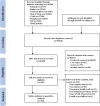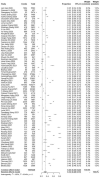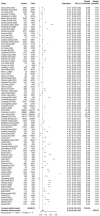The prevalence of psychological stress in student populations during the COVID-19 epidemic: a systematic review and meta-analysis
- PMID: 35840641
- PMCID: PMC9284967
- DOI: 10.1038/s41598-022-16328-7
The prevalence of psychological stress in student populations during the COVID-19 epidemic: a systematic review and meta-analysis
Abstract
Following the COVID-19 outbreak, psychological stress was particularly pronounced in the student population due to prolonged home isolation, online study, closed management, graduation, and employment pressures. The objective of this study is to identify the incidence of psychological stress reactions in student populations following a global outbreak and the associated influencing factors. Four English databases (Pubmed, Embase, Cochrane Library, Web of Science) and four Chinese biomedical databases (Chinese Biomedical Literature Database, VIP Database for Chinese Technical Periodicals, China National Knowledge Infrastructure, Wanfang) were searched in this study. We also retrieved other search engines manually. The search period was from the time of database creation to 10 March 2022. This study included cross-sectional studies related to psychological stress reactions in student populations during the COVID-19 epidemic. Three groups of researchers screened the retrieved studies and assessed the quality of the included studies using the Agency for Healthcare Research and Quality Cross-Sectional Study Quality Assessment Checklist. A random-effects model was used to analyze the prevalence of depression, anxiety, stress, and fear symptoms in the student population during the COVID-19 epidemic. Of the 146,330 records retrieved, we included 104 studies (n = 2,088,032). The quality of included studies was moderate. The prevalence of depressive symptoms in the student population during the epidemic was 32.0% (95% CI [28.0-37.0%]); anxiety symptoms was 28.0% (95% CI [24.0-32.0%]); stress symptoms was 31.0% (95% CI [23.0-39.0%]); and fear symptoms was 33.0% (95% CI [20.0-49.0%]). The prevalence differed by gender, epidemic stage, region, education stage, student major and assessment tool. The prevalence of psychological stress in the student population during the COVID-19 epidemic may be higher compared to the global prevalence of psychological stress. We need to alleviate psychological stress in the student population in a targeted manner to provide mental health services to safeguard the student population.
© 2022. The Author(s).
Conflict of interest statement
The authors declare no competing interests.
Figures





Similar articles
-
Immediate Psychological Responses and Associated Factors during the Initial Stage of the 2019 Coronavirus Disease (COVID-19) Epidemic among the General Population in China.Int J Environ Res Public Health. 2020 Mar 6;17(5):1729. doi: 10.3390/ijerph17051729. Int J Environ Res Public Health. 2020. PMID: 32155789 Free PMC article.
-
Psychological distress surveillance and related impact analysis of hospital staff during the COVID-19 epidemic in Chongqing, China.Compr Psychiatry. 2020 Nov;103:152198. doi: 10.1016/j.comppsych.2020.152198. Epub 2020 Aug 12. Compr Psychiatry. 2020. PMID: 32980595 Free PMC article.
-
Prevalence of depressive symptoms among Chinese university students amid the COVID-19 pandemic: a systematic review and meta-analysis.Epidemiol Psychiatr Sci. 2021 Mar 26;30:e31. doi: 10.1017/S2045796021000202. Epidemiol Psychiatr Sci. 2021. PMID: 33766163 Free PMC article.
-
Prevalence of anxiety and depression symptoms, and association with epidemic-related factors during the epidemic period of COVID-19 among 123,768 workers in China: A large cross-sectional study.J Affect Disord. 2020 Dec 1;277:495-502. doi: 10.1016/j.jad.2020.08.041. Epub 2020 Aug 26. J Affect Disord. 2020. PMID: 32882506 Free PMC article.
-
Knowledge, attitudes, and practices towards COVID-19 among college students in China: A systematic review and meta-analysis.PLoS One. 2022 Jun 16;17(6):e0270038. doi: 10.1371/journal.pone.0270038. eCollection 2022. PLoS One. 2022. PMID: 35709074 Free PMC article.
Cited by
-
Fear of COVID-19 and PTSD: The Protective Function of Problem-Solving Appraisals in Mental Health.Int J Environ Res Public Health. 2024 Feb 13;21(2):220. doi: 10.3390/ijerph21020220. Int J Environ Res Public Health. 2024. PMID: 38397709 Free PMC article.
-
An umbrella review of the prevalence of depression during the COVID-19 pandemic: Call to action for post-COVID-19 at the global level.BMC Public Health. 2024 Dec 23;24(1):3562. doi: 10.1186/s12889-024-21085-5. BMC Public Health. 2024. PMID: 39716132 Free PMC article.
-
The relationship between physical activity, life satisfaction, emotional regulation, and physical self esteem among college students.Sci Rep. 2025 May 7;15(1):15899. doi: 10.1038/s41598-025-00651-w. Sci Rep. 2025. PMID: 40335553 Free PMC article.
-
Postpartum Stress and the Occurrence of Breastfeeding-Related Spine Musculoskeletal Disorders Among Lactating Mothers in the Dschang Health District, Cameroon.Cureus. 2025 Mar 15;17(3):e80604. doi: 10.7759/cureus.80604. eCollection 2025 Mar. Cureus. 2025. PMID: 40230767 Free PMC article.
-
Prevalence of stress and associated factors among students in Ethiopia: a systematic review and meta-analysis.Front Public Health. 2025 Feb 17;13:1518851. doi: 10.3389/fpubh.2025.1518851. eCollection 2025. Front Public Health. 2025. PMID: 40034176 Free PMC article.
References
Publication types
MeSH terms
LinkOut - more resources
Full Text Sources
Medical

